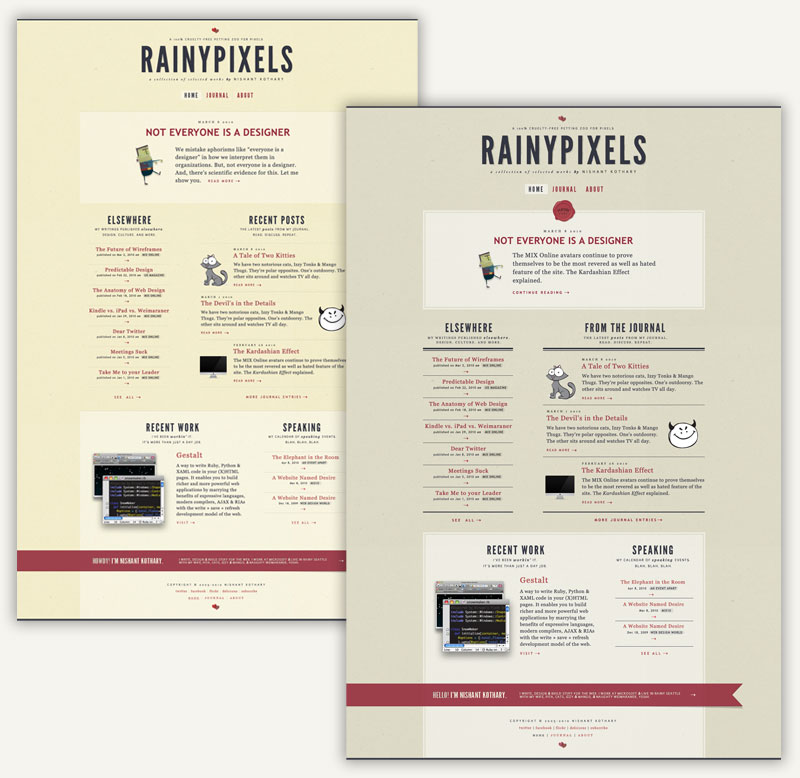
This site hasn’t been updated since 2012. You can still peruse who I was back then, but know that much of what I think, feel, write, and do has changed. I still occassionally take on interesting projects/clients, so feel free to reach out if that’s what brought you here. — Nishant
The seemingly insurmountable test of every personal project is your ability to deliver something that satisfies the worst critic of them all—you. The bar is virtually unachievable. After all, it must address every complaint you’ve ever had designing something for a third party and it must simultaneously delight you and world.
The Rainypixels journey became somewhat of a joke among my inner circle of friends. And for good reason. I started talking about launching a personal site in 2005—over five years ago. And since then, I've attempted to do so bi-annually only to abandon each attempt early in the design phase. The emotions I experienced always traversed a path similar to what Josh describes early in his article, Social Bulimia.
But, something changed recently.
Somehow, not only was I able to successfully build and launch this site, but also satisfy my own expectations. And in the process I stumbled upon the simple little two-part secret to designing successfully for oneself—a topic fitting for the inaugural post of this site.
As is often the case, the recipe for success was hidden in another's wisdom. Matt Brown wrote in his article, Discovering Trustworthiness—
Even today, it remains enormously difficult to design and launch a successful, well-designed website. Why? Because design is about much more than tactics and implementation. It's about answering the what question—aka, what’s the problem we’re trying to solve? It’s about finding the core question that frames a project.
I decided to heed Matt’s advice for this project and rounded up all the possible goals for Rainypixels—the whats. I listed them shamelessly—everything from creating a blogazine-style site like Jason's to a comprehensive section of professional highlights. Once they were all up on my whiteboard, I painstakingly prioritized them like one of those packrats from the TV Show, Hoarders; only instead of physical stuff, I was sifting through and stacking project goals I’d hoarded over a decade.
In the end, I was left with one:
A respectable destination for my past and future writings.
In other words, I’d determined that the most important goal of the Rainypixels project was to give me the ability to write on the Web. Simply put, a blog. And this goal trumped all other goals, meaningful and frivolous, alike.
Discovering the what is half the battle.
Based on experience and taking into account the simplicity of the primary goal, i.e. to create a respectable blog, I gave myself 10 hours to design the entire site—that is, I had 10 hours to go from a goal to IA to full-fidelity comps complete with copy. I disclosed this information to my wife, Pita, inviting an unspoken contract between us. It allowed her to pay me surprise visits whenever I was cooped up in my home office "designing", and if it seemed like I was veering off path, she could crack her whip.
Between my determination—admittedly, it was not unlike that of an addict trying to quit—and Pita's timely interventions, I was able to stay the path. They helped me steer clear of the hoarded aspirations that I mentioned earlier. They also helped me lower the bar from perfect to realistic during every phase of the project.

Even though designers love to complain about working with clients and stakeholders, there’s a tremendous hidden benefit of client projects—they almost always come with some combination of limitations. And whether it’s budget, feature scope, art direction preferences, or technical requirements, the limitations always have the effect of reigning in the runaway idealist in every designer. This dynamic forces a realistic answer to the what question. It is also one that must be emulated if we wish our most personal design projects to see the light of day.
Committing to the what with true discipline is what lets you win the war.
After all these years of searching for the secret behind designing successfully for oneself, the answer turned out to be as obvious as the snout on a Weimaraner’s face—answer the what, and then commit to it with true discipline.
Fate, it seems, loves irony. Nonetheless, the Rainypixels journey seems to have met a happy ending. As I sit here typing this, I feel I’ve understood a little more about design, life and myself. And the best part is that now I have a real place to share it.
So, grab a seat, make yourself comfortable, and don't forget to say hello below.
comments powered by Disqus